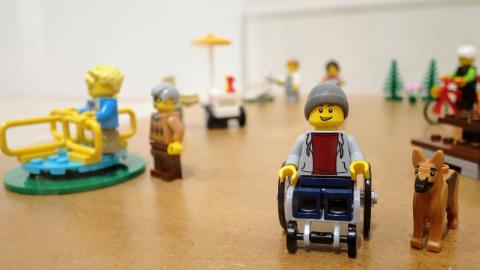Why Lego’s Wheelchair Minifigure Is Fearfully and Wonderfully Made
1 comment
421 views

A new Lego minifigure has been greeted with celebration, even though it has nothing to do with Star Wars or superheroes. Instead, this figurine is of a young man in a wheelchair sporting a hoodie and beanie cap.
Lego had previously released a minifigure of an elderly man in a wheelchair for their Duplo line, but that received criticism from disability activists for reinforcing the stereotype that wheelchairs are only for elderly people. Clearly such a depiction didn’t account for “wheelchair freestyle” practitioners like this.
Millions of kids in North America have service animals or use a variety of adaptive equipment, including wheelchairs, visual aids, hearing aids, canes or crutches. These kids don't expect to play with toys that look like them. For a long time, mass marketing meant creating toys that would look like the broadest segment of the population — or like the aspirations of the broadest segment of the population.
As an example of an aspirational toy, consider that Barbie has resembled supermodels throughout most of her history. But Barbie too is changing, in a way that was significant enough to make Time magazine’s cover story. Mattel recently released a new line of Barbie dolls that include petite, tall and curvy body shapes, along with seven skin tones, 22 eye colors, 24 hair styles and even flat feet. (Classic Barbies will still have pointy feet to accommodate high heels.)
What’s going on here? Surely, marketing and sales, as well as the fact that modern manufacturing processes allow for a much broader array of toys than was possible in the past. Yet something else is afoot too. As North American society grows increasingly diverse, people are becoming tired of toy manufacturers determining what the typical child or adult looks like or should look like.
Someone once told me that after he, his wife and their young daughter were involved in a serious car accident, their daughter would play “car crash” every day. Kids use play to learn about and interpret the world in which they live. So I’m thrilled that Lego finally has a figure in a wheelchair that can be part of childhood play. And I’m thrilled that an activist group such as Toy Like Me lobbies manufacturers to create toys of kids and adults with various disabilities and adaptive equipment.
Although we are all alike in that each of us is made in the image of God, each of us is also fearfully and wonderfully made in our own ways. Regarding disability and religion, John Swinton has written, “When we learn to see the holiness of even the most broken body, we act differently; we function generously and gently. We become people who can be trusted with the welfare of others.”
I don’t expect that toys will change human hearts — only God can do that. But maybe Lego minifigures in wheelchairs and dolls with various shapes and colors will help kids to become a little kinder, a little more generous. Maybe these toys will encourage kids who use wheelchairs or who do not look like supermodels to understand that they have an important place in society. My hope rests alongside that of Toy Like Me founder Rebecca Atkinson, who said, “This move by Lego is massive in terms of ending cultural marginalization. It will speak volumes to children, disabled or otherwise, the world over.”
This post originally appeared on Think Christian.
Disability Concerns, Church Admin & Finance
Disability Concerns, Church Admin & Finance
Disability Concerns, Training and Education
Disability Concerns
Connect to The Network and add your own question, blog, resource, or job.
Add Your Post
Comments
Not only toy makers but also clothing makers are expanding their line to include kids with disabilities. Here's a story about Tommy Hilfiger's work.
Let's Discuss
We love your comments! Thank you for helping us uphold the Community Guidelines to make this an encouraging and respectful community for everyone.